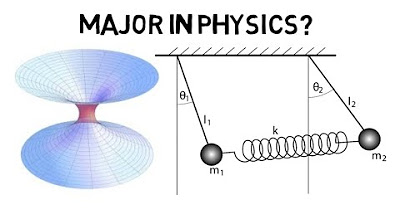What is Physics? (and what do physicists do)
TLDRThis enlightening script delves into the vast and varied world of physics, exploring its split into theoretical, experimental, and applied branches. It highlights theoretical physics' role in understanding complex phenomena like wormholes and the fabric of the universe, influenced by Einstein's theories of relativity. By examining the Standard Model, it ventures into the subatomic realm, shedding light on fundamental particles and quantum physics. The script also showcases physics' practical applications, from groundbreaking inventions like X-ray machines to everyday technologies such as insulation and air conditioning, emphasizing physics' pivotal role in advancing technology and understanding the cosmos. Moreover, it touches on educational initiatives like Aveea Projects, aimed at inspiring future generations in STEM fields.
Takeaways
- 😀 Physics is a vast field covering theoretical, applied and experimental areas.
- 👩🔬 Theoretical physics uses complex math to explain phenomena like wormholes.
- 🌌 Understanding the fate of the universe relies on theoretical physics.
- 🔬 Experimental physics led to X-rays and MRI scanners.
- 💡 Applied physics brings concepts to real-world use like in engineering.
- ⚛️ The Standard Model classifies fundamental particles of matter.
- 🔭 NASA has contributed technology like insulation and laser eye surgery.
- 😎 Thermodynamics allows air conditioning and efficient engines.
- 📺 Cathode ray tube technology enabled television screens.
- 🛰 Physics equations are critical for weather forecasting and flight simulation.
Q & A
What are the three main branches of physics?
-Theoretical physics, experimental physics, and applied physics.
What is theoretical physics focused on?
-Theoretical physics is focused on using mathematical models and abstractions to explain phenomena in the universe and to predict outcomes.
How did the discovery of X-rays impact the medical industry?
-The discovery of X-rays by Wilhelm Röntgen allowed doctors to see inside the human body without surgery, revolutionizing medical diagnostics.
What are some examples of how physics equations are applied in the real world?
-Physics equations are used in flight simulators, weather forecasting, structural analysis, computing gravitational and magnetic fields, and modeling natural disasters like tsunamis.
What is the standard model in physics?
-The standard model explains the fundamental particles that make up matter in the universe, such as electrons, protons, neutrons and quarks.
What are some unsolved mysteries in physics?
-Some unsolved mysteries include: the nature of dark matter and dark energy, the possibility of time travel, whether there are additional dimensions, and how to unify quantum mechanics with general relativity.
How did the discovery of MRI scanners relate to physics research?
-MRI scanners rely on the principles of nuclear magnetic resonance, which was discovered through experimental physics research.
What is condensed matter physics?
-Condensed matter physics deals with the structure and properties of solids and liquids, which have unique behaviors due to the dense packing of molecules.
How did cathode ray tubes lead to the development of TVs?
-Experiments with cathode rays in vacuum tubes led to the discovery that they could generate images, forming the basis for cathode ray tube TVs and computer monitors.
Why is physics important for space exploration?
-An understanding of physics allows us to launch rockets into space, keep spacecraft operating in extreme conditions, and model the universe to guide exploration.
Outlines
😊 Introduction to Physics and its Branches
Paragraph 1 introduces physics as a massive field that can be categorized into theoretical, experimental, and applied branches. It highlights theoretical physics concepts like Einstein's relativity, wormholes, dark matter/energy, and string theory. It also mentions the Standard Model of particle physics.
😃 Real-World Applications of Physics
Paragraph 2 discusses applied physics, highlighting examples like X-ray machines, MRI scanners, flight simulators, and weather forecasting models. It emphasizes physics' role in critical systems where lives depend on accurate equations.
Mindmap
Keywords
💡theoretical physics
💡standard model
💡x-ray
💡thermodynamics
💡cathode ray tube
💡equations
💡space exploration
💡experimental physics
💡applied physics
💡STEM education
Highlights
The researchers developed a new technique to image tau tangles in the brain using PET scans.
The study found a strong correlation between the amount of tau tangles and the severity of Alzheimer's symptoms.
Using machine learning algorithms, the researchers were able to predict Alzheimer's progression based on tau PET scans.
The imaging technique allows earlier detection of Alzheimer's disease, before onset of dementia.
The study provides evidence that targeting tau tangles could be an effective treatment strategy for Alzheimer's.
Researchers emphasized the need for larger clinical trials to validate the predictive power of tau imaging.
The PET tracer used in the study specifically binds to tau aggregates, allowing direct imaging of tangles.
The study found tau tangles initially form in the medial temporal lobe before spreading to other brain regions.
Researchers plan to investigate whether reducing tau tangles can slow or prevent cognitive decline in Alzheimer's.
The imaging technique may allow earlier enrollment in clinical trials for Alzheimer's treatments.
Researchers are hopeful the technique could be used to monitor response to tau-targeting therapies.
The study provides some of the first in vivo evidence linking tau tangle accumulation to Alzheimer's progression.
Researchers emphasized the need for further validation in larger and more diverse patient cohorts.
The imaging technique could potentially aid diagnosis and disease monitoring in clinical settings.
Overall, the study demonstrates promise for tau PET scans in advancing Alzheimer's research and treatment.
Transcripts
Browse More Related Video

Seven Brief lessons on Physics by Carlo Rovelli | ANIMATED BOOK SUMMARY

The Map of Black Holes | Black Holes Explained

The Universe: Breaking Barriers to Reach Light Speed (S3, E3) | Full Episode | History

What does a Physics major do? (Part 1: Curriculum and Subfields)

The Role of Moment of Force in Daily Life - Everyday Physics

The Interpretations of Quantum Mechanics

The Physics Major
5.0 / 5 (0 votes)
Thanks for rating: